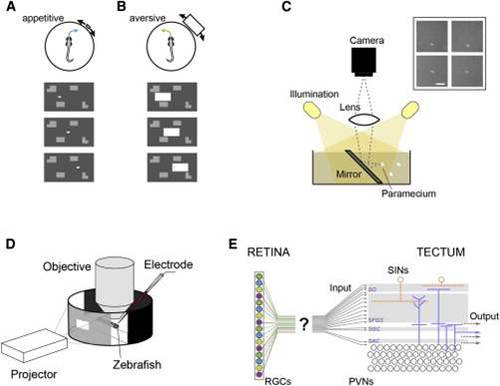Fig. 1
- ID
- ZDB-FIG-150312-47
- Publication
- Preuss et al., 2014 - Classification of Object Size in Retinotectal Microcircuits
- Other Figures
- All Figure Page
- Back to All Figure Page
|
Size Discrimination in the Retinotectal Pathway using Ethological Stimuli (A and B) “Appetitive” versus “aversive” swim. A zebrafish larva performs swims directed toward a small moving target (A) or away from a large target (B). The stimulus paradigm is shown in the bottom panels; a white rectangle moves on a gray background with stationary objects. (C) Configuration for imaging paramecia as seen from the perspective of hunting zebrafish. Inset: examples of paramecia. Note that paramecia appear as bright objects on a dark background. Scale bar, 0.5 mm. (D) Experimental set up for multiphoton imaging and patch-clamp recordings, in combination with behaviorally relevant visual stimulation. (E) The retina contains functionally distinct RGC subtypes (schematically highlighted by color). The tectum receives RGC input mainly in the superficial layers (stratum opticum and stratum fibrosum et griseum superficiale), but how functionally distinct RGC subtypes map onto these layers is unclear. |

